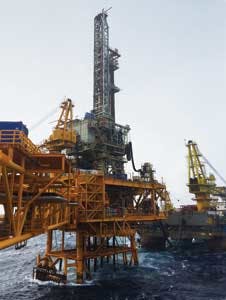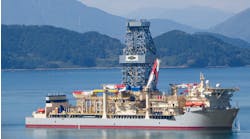Brent Emerson
Weatherford
As offshore E&P operations continue to move into deeper waters and more geologically complex reservoirs, the risks and costs of well construction continue to rise as well.Deepwater operators are tasked with minimizing these risks and costs while building high-integrity wells that not only meet long-term production objectives, but also comply with governmental regulations on safe and environmentally responsible practices.
Assuring well integrity for the long term means successfully navigating through a myriad of well construction challenges. These include geologic uncertainty, narrow pore pressure/fracture pressure gradients, and borehole instability risks. Without understanding these challenges, the operator runs the risk of not getting the well to target, improper casing design and equipment performance, inadequate zonal isolation, lost circulation and ultimately, loss of the well.
Addressing these challenges requires a collaborative approach to well construction between the operator, the drilling contractor, and the service companies that contribute to the project. It also requires a sophisticated solution that orchestrates many drilling, casing running, and completions technologies with multi-disciplinary teams that possess the necessary application expertise.
The following reviews the major well integrity initiatives that might be implemented at each stage of well construction, and provides field examples of how these initiatives impacted well integrity.
Early involvement essential
Ensuring well integrity ideally begins before the drill bit ever enters the seafloor—at the early stages of well planning. Upfront discussions during the planning stage give all parties a thorough understanding of the operator's ultimate production goals for the well and the geologic and geomechanical challenges expected in the reservoir. With this information, the multi-disciplinary planning team can agree to the best combination of tools and services—from the drill bit to the cement—to ensure the well reaches total depth (TD) on time and within budget.
Early collaboration also allows for contingencies to be prepared should the construction program deviate from the original plan. Having secondary tools and procedures in place to drill through a weak part of the formation, for example, will allow drilling to commence faster to TD rather than having to develop a solution "on the fly." The well will thus be installed with fewer surprises, resulting in more reliable and optimized well performance.
Drilling to depth
Assuring deepwater well integrity during drilling translates to applying the proper services to successfully navigate through narrow pore pressure/fracture pressure gradients, ensure robust zonal isolation, and minimize kicks or lost circulation events, all while reaching TD at a high rate of penetration (ROP). This begins with measurement-while-drilling (MWD) services such as Weatherford's hostile environment logging (HEL) MWD system, which combines a multi-frequency resistivity, high-temperature sensor with real-time information logging-while-drilling (LWD) data transmission services.
If trouble zones cannot be avoided without adding costs and time todrilling, all stakeholders should work together to develop the best drilling solution. Managed pressure drilling (MPD) systems, for example, enable operators to drill through troublesome pressure zones while maintaining control of the well and minimizing nonproductive time (NPT). Rotating control devices (RCD), a major component of a MPD system, create a closed-loop drilling environment, enabling ultra-precise control over fluids flowing into and out of the well. Using the Weatherford Microflux system, MPD allows for detection and effective management of minute fluid influxes or losses, thereby preventing major well control incidents from occurring.
Deploying solid expandable liners and drilling with casing or liners provide other means of isolating drilling hazards and achieving zonal isolation. Solid expandable tubulars not only provide a unique isolation solution for planned and contingency applications, but also they conserve hole size to help reach TD and enable the optimal completion. Drilling with liners or casing through depleted reservoirs or a severe lost circulation zone is an effective solution to isolate these hazards and ensure planned casing seats.
An operator drilling offshore Vietnam required such a contingency loss-control option while drilling a 12¼-in. open hole section. A monobore open hole expandable liner system was run to a TD of 10,488 ft (3,197 m) at a rate of 1 m/min to prevent fluid losses. Cement displacement and liner expansion operations (from 11¾ in. to 12¼ in.) were conducted successfully. The liner system isolated the lost circulation zone for continued drilling of the 12¼-in. open hole. The system also provided sufficient annular bypass for cementing the 10-in. x 135⁄8-in. liner at planned depth, without further losses.
Regardless of the drilling method selected, successful execution depends on collaborative engineering and operations to minimize risks, reduce flat time, and deliver well integrity.
Smooth running
Successfully drilling each interval in a deepwater well is a precursor to running the casing to TD and cementing it in place. Underreamers also help get the pipe to depth, by enlarging the hole and allowing pipe joints to reach their planned distance in the wellbore without having to step down in pipe size prematurely. The resulting full-gage, high-quality hole also aids subsequent completion and cementing operations, and allows for better management of equivalent circulating density (ECD) in softer formations where lost circulation events are a concern.
Such a solution was instrumental in the drilling of a 12¼-in. pilot hole in a deepwater Gulf of Mexico well. Weatherford deployed its RipTide Rathole Killer drilling reamer beneath an MWD turbine restriction and enlarged 730 ft (223 m) of the pilot wellbore to 14½ in. The tool minimized the rathole to less than 15 ft (4.6 m), which allowed the operator to set the casing shoe in the desired zone. It also eliminated a dedicated clean-out run, saving three days of rig time valued at nearly $3 million.
During casing running operations, the make-up of each casing connection is also critical for well integrity. Ensuring connection integrity reduces NPT and operator costs, and helps operators stay in compliance with increasingly stringent regulatory requirements. And connection integrity is becoming even more critical as deepwater well construction operations increasingly embrace new tubular designs containing premium connections with metal-to-metal seals.
This calls for the use of specialized, propriety technology that can ensure gas-tight seals designed to withstand high-torque and bending stresses. The JAMPro (Joint Analyzed Make-Up) torque monitoring system, for example, provides real-time monitoring of tubular make-up for each connection. The system monitors the torque, turns, and speeds of any power tong in real time, and uses this data to help control make-up and ensure that each connection conforms to manufacturer specifications.
Displaying 1/2 Page 1,2Next>
View Article as Single page





